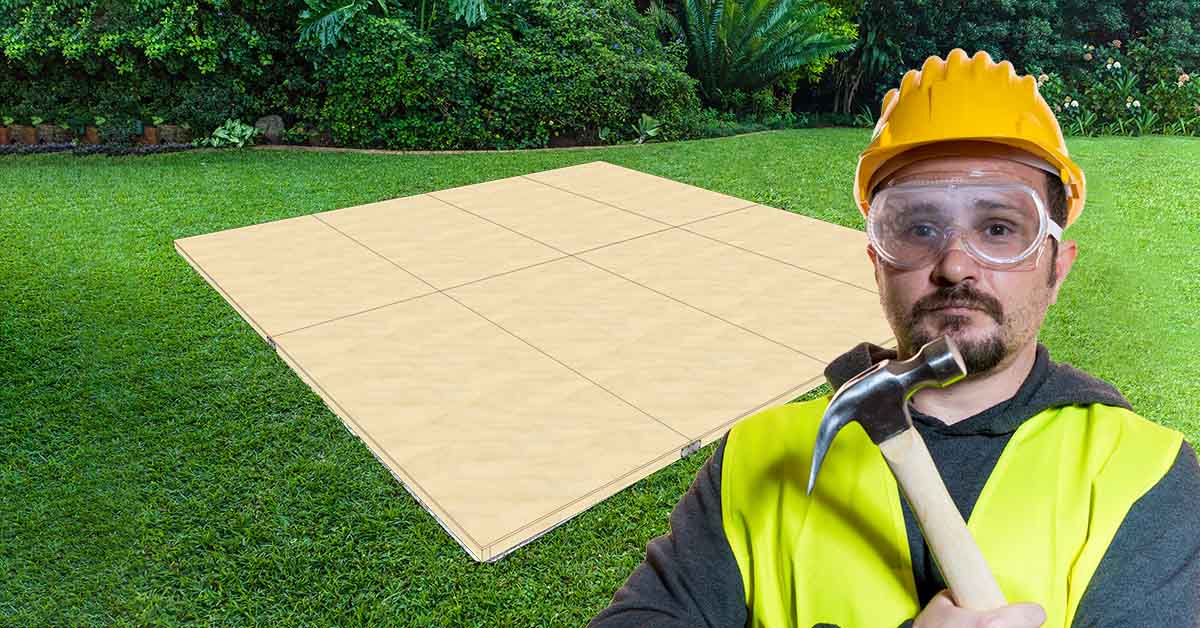How to Build a Dance Floor Out of Plywood?
Building a backyard dance floor out of plywood can sound like a daunting task, but it isn’t that difficult if you follow a few basic rules.
There are many man-made materials you can make a dance floor out of. But it makes sense to build a DIY outdoor dance floor with plywood, as it is affordable, and you only need a handful of materials and tools.
In this project, we are not going to build a professional dance studio. We will make a dance floor outside on the grass.
Why Should You Consider Wood?
Wood is an excellent option for a dance floor because it gives a little. This, in turn, does a better job at protecting your ankles, knees, and your other joints.
Wood is both comfortable to dance on and protective of your joints. Concrete, linoleum, and ceramic tile can’t provide that. In dances with a lot of pounding, this is especially important.
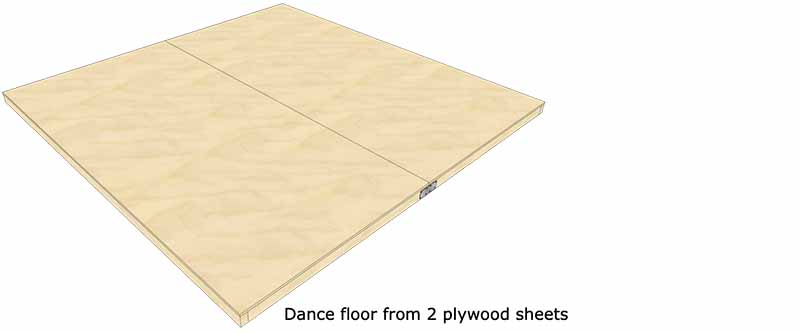
When it comes to wood, plywood seems to be a great choice. Plywood is inexpensive yet provides the right amount of giving versus stability to take good care of the people who dance on it.
How to Calculate the Size of the Dance Floor
If you just need a small dance floor so you can practice on it, a four-foot square piece of plywood will likely be enough.
But if you need a dance floor for an outdoor wedding, for example, you’ll have to go with a different plan. Size the floor based on how many guests you will have and how much space you have available.
According to industry standards, the dance floor should be large enough to accommodate 30 to 50% of your total invitee list at one time. Calculate 4.5 square feet per dancer on average.
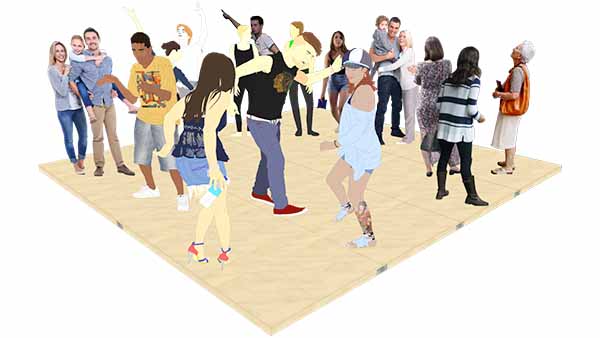
Now let’s do the math:
- The dance floor will be occupied by 30-50% of the guests simultaneously. Let’s use 40 % as our average.
- Each person requires 4.5 square feet (9 square feet for a couple).
- A party with 100 people is likely to have 40 people or 20 couples on the dance floor at any given time.
- This means we will need a dance floor of approximately 180 square feet (17 square meters) for an event with 100 people.
However, there are other factors to consider as well:
- What is the ideal size and location for your outdoor space?
- How much time are you willing to allocate to building a floor?
- How much are you ready to spend? The bigger the dance floor, the more money you will shell out (the total cost of wood material for a floor with six sheets can go up to $350).
Plywood sheets Sizes
Plywood sheets are universally sized at 4 by 8 feet (48 x 96 in., 1.22 x 2.44 m). That is around 32 square feet (3 square meters).
Practical sizes for a dance floor made of plywood are:
- 2 plywood sheets: 8 x 8 feet (2.44 x 2.44 m), 64 square feet (6 square meters)
- 3 plywood sheets: 8 x 12 feet (2.44 x 3.66 m), 96 square feet (9 square meters)
- 4 plywood sheets: 8 x 16 feet (2.44 x 4.88 m), 128 square feet (12 square meters)
- 6 plywood sheets: 12 x 16 feet (3.66 x 4.88 m), 192 square feet (18 square meters)
- 8 plywood sheets: 16 x 16 feet (4.88 x 4.88 m), 256 square feet (24 square meters)

What Plywood Type to Choose?
Wood floors are great for certain types of dancing, such as country, western, and ballroom. Other types of dancing may require a different kind of floor.
Consider this:
- Is the plywood the dance floor itself?
- Or is it a subfloor for something else to be put on top of it?
If the plywood is going to be used without any floor covering, it’s best to go with sanded softwood plywood, such as an AB or AA sheet of 1/2 inch plywood. Here you can find more information about plywood grades.
Note: 1/2-inch is the nominal thickness, actual thickness is 15/32 inch.
If the plywood is a subfloor for another flooring, like linoleum tile, you can use less expensive plywood if you like.
Steps to Build DIY Dance Floor on Grass
We certainly have some challenges when building a dance floor on grass.
First, the ground is uneven; second, the individual plywood panels must be securely connected together.
Let’s have a look at how to do this.
Step 1: Determine the size and the location
Select an area that is level and large enough to accommodate the dance floor. Allow space around the dance floor for people to move around.
Step 2: Collect materials and tools
Obtain the correct number of 4 x 8 feet plywood sheets of 1/2-inch (1.2 x 2.4 m x 1.2 cm).
For the frame, purchase 2 in x 3 in x 8 feet wood studs (5.1 x 7.6 cm x 2.4 m).
Note: 2 x 3 is the nominal size. Actual size is 1 1/2 x 2 1/2 inches (38 x 64 mm).
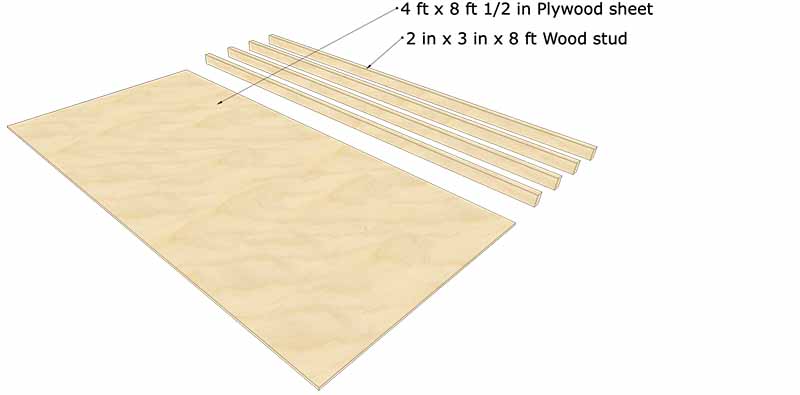
Each plywood sheet requires 4 wood studs. 2 pieces go along long edges, 2 are cut to form shorter support pieces of 45 in (114.3 cm).

If you build a 12 x 16 feet (3.66 x 4.88 m) dance floor, you need 6 plywood sheets and 24 joists.
Step 3: Build the framework
For each plywood sheet, construct a supporting framework:
- Set one sheet on the ground to help with measurement.
- Align two joists along the long sides.
- Cut two posts to retain four shorter support pieces of 45 in (114.3 cm) each.
- Set them inside the two longer joists.
- Screw the pieces together with 3-inch screws.
- Build one unit for each sheet of plywood you have.
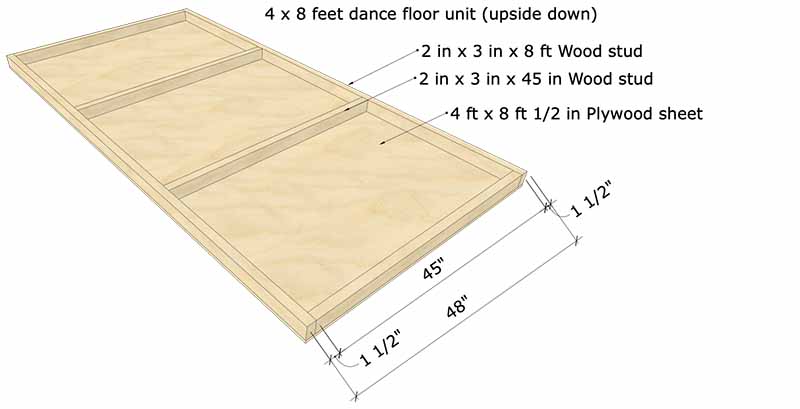
Step 4: Attach the plywood sheet to the framework
After the framework is built, attach the plywood to it using either countersunk screws or nails.
It might also be good to glue the plywood to the supporting structure. That way, the plywood won’t separate from the system when moving it.
Step 5: Attach the units to each other
To attach the units, you have two options:
- Drill through the adjacent frame pieces, then bolt the units together. Other option is to use corner braces. Flipping over the floor after being bolted together is the trickiest part of this option.
- Attach mending plates to the outside corners of the units. The floor will then be fastened together through those plates. By doing this, you do not have to flip the unit over when you are done.
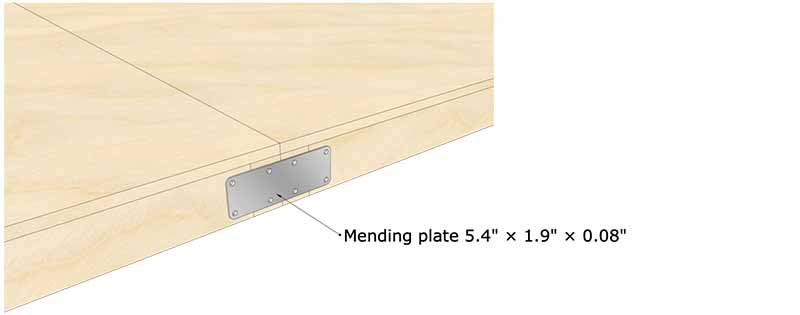
Step 6: Finishing
Finally, you can finish the floor with varnish to make it last. If you find any holes or voids in the surface, fill it with a wood putty made explicitly for flooring.
You can also mount vinyl flooring (like this No products found.), or a vinyl dance mat, like in the image below, to the plywood to make it look more professional.

Plywood Dance Floor on Hard Surface
If you build your wooden dance floor on a hard surface, like stone or concrete, it needs to be cushioned to protect the dancer’s ankles and knees.
The easiest way for a dance floor like this is a roll of closed-cell foam subflooring. You can also choose foam panels instead if that’s what you prefer.
Ready-made Dance Floor Kits
If all this sounds too complicated, you can always rent a dance floor, or get a ready-made dance board kit. You set up the floor from the tiles like this:

Extra Items to Spruce up Your Backyard Dance Floor
1. Entrance to Your Dance Floor
Adding an entrance to an outdoor wedding is a nice touch. A wedding arch makes a stunning entrance to the dance floor. You can also use it for other events like birthdays. You only need to change the decoration on the arch.

2. Fencing
Another way to add style is with fences. Fences are also a great way to decorate, and you can even attach lights to them.

3. Lights
As the sun sets, the backyard lights add a lot of charm to the dance floor and whole area.
These Outdoor lights can be used all year round for a variety of reasons.

This type of lighting can be used on special occasions, like weddings, or just to brighten up a dark area of your backyard.
If you are hanging those string lights around the dance floor, and there are no trees, learn more about how to hang outdoor string lights without trees.
These sound-activated outdoor party lights can liven up any party or get-together.

4. Folding chairs and tables
The convenience of folding chairs and tables makes them easy to transport to any location. The otherwise dull white folding chairs can be easily decorated for an outdoor wedding.
You can find more backyard party decoration ideas in our other piece of article.
The Bottom Line
Dancing in the grass is not possible with heels. In other words, if you want a low-key event, arrange the dance on the grass, but have the guests bring flip flops (or provide them yourself).
If you want a proper dance floor on grass, you can rent one or build one from plywood. Making a dance floor from plywood can be simpler than you thought.

